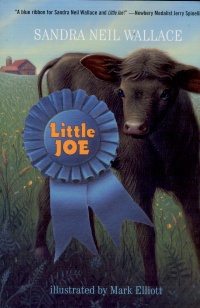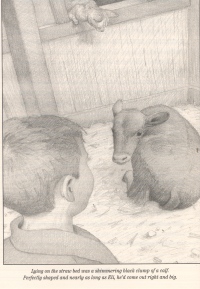| ________________
CM . . . . Volume XVII Number 16. . . .December 17, 2010. 
 |
Little Joe.
Sandra Neil Wallace. Illustrated by Mark Elliot.
New York, NY: Alfred A. Knopf (Distributed in Canada by Random House Canada), 2010..
184 pp. hardcover, $18.95.
ISBN 978-0-375-86097-3.
Subject Headings:
Bulls-Fiction.
Farm life-Fiction.
Country life-Fiction. Little Joe
Grades 4-7 / Ages 9-12.
Review by Betty Klassen.
***½/4
|
| |
|

excerpt:
All three of them were covered in sawdust when Pa came into the barn. Eli stumbled to his feet and shook off the bits of wood.
"What are you doin' here, son?"
Eli rushed to get the feed bucket outside the pen. "The calf keeps growin', Pa," she murmured. "Thought I'd feed him. In case there was a flood or something. On account of all that rain."
Pa craned his neck, looked up at the pen's ceiling, then kicked up some sawdust. "Looks dry to me," he said. "Listen. He's gotta learn to be on his own, Eli."
"But he's barely a teenager."
"Who told you that?"
"Grandpa."
Pa took his cap off, then put it back on. "Sounds like you're spending a whole lot of time talking and not enough on chores." Pa walked to the tack room and got out the spade, the one with the sharpest point. Eli knew what that meant. "Just 'cause you got a bull calf don't mean you can quit on your chores." Pa handed him the shovel. "It's time you dug up thistles."
"But I got school." The hair on Eli's arms bristled. He hated digging thistles. And he was certain Pa knew it. Last year he got at least one bubbly blister from the wooden handle, and his eyes stung whenever a pricker whittled its way into the work gloves.
"Start with the pine fields, Eli. There's at least an hour before school."
Little Joe is a first novel for network TV announcer Sandra Neil Wallace, and it is also a book of firsts for the protagonist, nine-year-old Eli Stegler. Little Joe is Eli's first calf to raise and show, he drives the tractor for the first time, and he also is allowed to stay up late for his first "Big Night."
The novel opens on Christmas Eve, but Eli's interest in the holiday celebration is nothing compared to the excitement of being given the gift of a bull calf to care for, train and show. It is a coming of age routine for the Stegler men, and the pressure is on Eli to win the blue ribbon, since both his grandfather and father have won blue ribbons showing their first calves. The author's attempt to have the reader wonder along with Eli about whether or not he will be able to win the blue ribbon falters somewhat since the front cover features a beautiful illustration of a Black Angus calf with a blue ribbon..
The novel opens on Christmas Eve, but Eli's interest in the holiday celebration is nothing compared to the excitement of being given the gift of a bull calf to care for, train and show. It is a coming of age routine for the Stegler men, and the pressure is on Eli to win the blue ribbon, since both his grandfather and father have won blue ribbons showing their first calves. The author's attempt to have the reader wonder along with Eli about whether or not he will be able to win the blue ribbon falters somewhat since the front cover features a beautiful illustration of a Black Angus calf with a blue ribbon..
Each of the 17 chapters features a small illustration under the chapter title. The illustrator, Mark Elliot, has drawn seven full page pictures to depict key events in the novel. A detailed sketch on both of the endpapers is useful for the reader to understand the various parts of a "beef animal" when they are written about in the text. Because the author makes a point of using specific vocabulary, readers learn the barn is made from "bluestone, the red tractor is a Farmall, Eli wears a Dickie barn coat, the milk cows were Holstein, and the beef cattle are Angus, to mention just a few of the text's specific details.
 Wallace provides a detailed explanation of life on a farm, an honest representation of the hard work and tight financial straits that many farmers have been living through or are facing today. Eli's dad works at the saw-mill, and his mom cuts hair and is proposing to raise free-range chickens to earn extra money. His dad is a proud farmer, still hurting from the changeover to raising Angus beef cattle instead of being able to maintain the multi-generational family dairy farm. Wallace provides a detailed explanation of life on a farm, an honest representation of the hard work and tight financial straits that many farmers have been living through or are facing today. Eli's dad works at the saw-mill, and his mom cuts hair and is proposing to raise free-range chickens to earn extra money. His dad is a proud farmer, still hurting from the changeover to raising Angus beef cattle instead of being able to maintain the multi-generational family dairy farm.
The first few chapters focus on Eli's getting to know his calf, naming him, and caring for him. Just when this starts to drag, the plot picks up, and numerous events engage the reader, including Eli's being challenged by his nemesis, Keller, a tough neighbour kid who eggs Eli on and tries to get him to disobey his father.
The sternness of Eli's father is balanced by the gentle wisdom of Eli's grandfather, who guides Eli in training his calf, while his father does the difficult or more unpleasant tasks, such as separating the calf from his mother to wean him and tattooing his ear for identification purposes. Wallace includes all necessary steps in running a business where animals are not meant to be pets but are bred, raised, and sold to make money and keep the farm going. Eli, of course, does not want to think about Little Joe being sold to become someone's dinner.
Life and death is a recurring theme in the novel, but Eli's grandfather is teaching Eli to continue to look for the wonder in life. He takes Eli out for his first "Big Night," which is an annual spring event when the salamanders cross the road. Many die crossing the road, but enough of them make it across to the pond, find a mate and continue the cycle. Eli is witness to "one of nature's little miracles" as he and his grandfather help more of them cross the road safely.
Most of the story's focus is on Eli, his grandfather and his dad, but Eli's younger sister, Hannah, and his mother play supporting roles in the plot. Hannah is most often portrayed as the "bratty little sibling," but there are occasional moments where they share a common concern. Eli's mother surprises him when she is welcoming and supportive of his "friend" Keller after his arm is broken while Keller's parents are away. Spending more time with Keller and watching his mother with him, Eli learns to see behind the toughness and to understand it as a show of bravado. Eli also finds the opportunity to learn something about his father that helps him see past the sternness.
Recommended.
Betty Klassen teaches in the Middle Years Program in the Faculty of Education at the University of Manitoba.

To comment on this title or this review, send mail to
cm@umanitoba.ca.
Copyright © the Manitoba Library Association. Reproduction for personal use is permitted only if this copyright notice is maintained. Any other reproduction is prohibited without permission.
NEXT REVIEW |
TABLE OF CONTENTS FOR THIS ISSUE- December 17, 2010.
AUTHORS |
TITLES |
MEDIA REVIEWS |
PROFILES |
BACK ISSUES |
SEARCH |
CMARCHIVE |
HOME |

 Wallace provides a detailed explanation of life on a farm, an honest representation of the hard work and tight financial straits that many farmers have been living through or are facing today. Eli's dad works at the saw-mill, and his mom cuts hair and is proposing to raise free-range chickens to earn extra money. His dad is a proud farmer, still hurting from the changeover to raising Angus beef cattle instead of being able to maintain the multi-generational family dairy farm.
Wallace provides a detailed explanation of life on a farm, an honest representation of the hard work and tight financial straits that many farmers have been living through or are facing today. Eli's dad works at the saw-mill, and his mom cuts hair and is proposing to raise free-range chickens to earn extra money. His dad is a proud farmer, still hurting from the changeover to raising Angus beef cattle instead of being able to maintain the multi-generational family dairy farm.